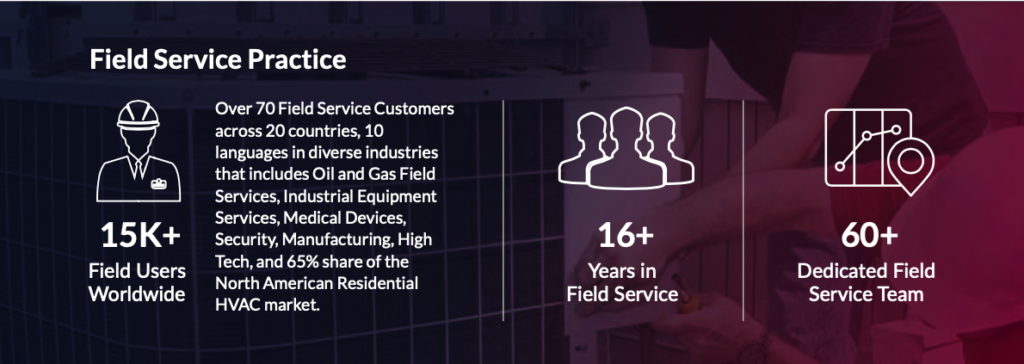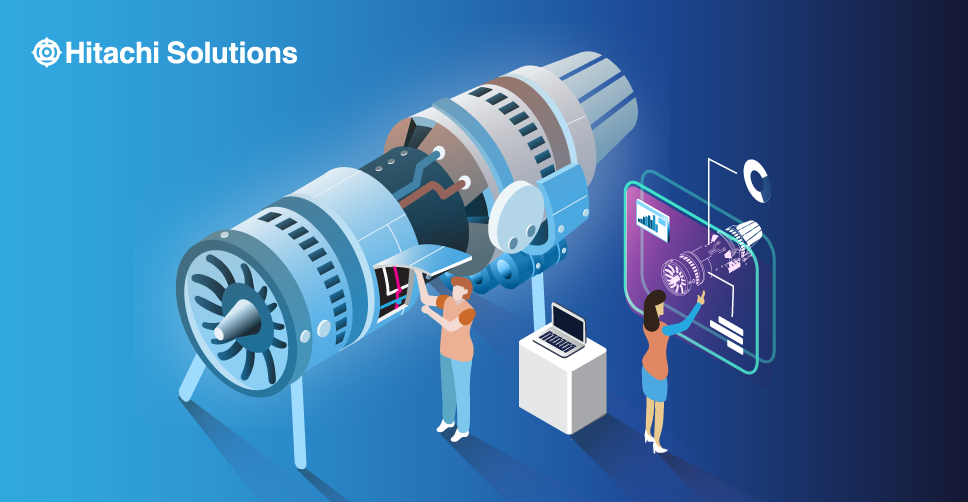

Digital Transformation Playbook
Is your business ready to reimagine how it operates?
Download the EbookThis report is based on recommendations made in a webinar hosted by WBR Insights and presented by Hitachi Solutions. The webinar focused on bridging gaps within service strategies in order to meet shifting customer expectations around outcome-based service models.
What is Outcome-Based Service?
Here at Hitachi Solutions, we define an “outcome-based service model” as one that prioritizes measurable and meaningful results over human- and resource-oriented inputs. This entails delivering sustained value to the customer throughout the lifecycle of a service contract, while simultaneously working to generate a steady stream of profit, either through cross-selling or outcome-based contract incentives.
To achieve this, manufacturers must leverage the latest technologies — including mobile devices, the internet of things (IoT), predictive analytics, and artificial intelligence (AI) — to gain real-time visibility into equipment performance and provide proactive service.
Contextualizing the Movement Towards Outcome-based Service Models
In an increasingly competitive marketplace, manufacturers must look to generate and maintain as many revenue streams as possible; this includes transitioning their field service departments from a cost center to a profit center. In light of this, there’s been an industry-wide shift toward adopting an outcome-based service model as opposed to the traditional break/fix service model.
Many manufacturers also see outcome-based service as a real opportunity to differentiate their business and evolve into a service-led organization. For companies that undergo this evolution, it redefines how they go to market; how they compete; and how they interact with customers, channels, and partners within their ecosystem. It also creates new growth opportunities and better enables them to meet changing customer needs.
Where Does Product as a Service Come into Play?
Product as a Service (PaaS) is a form of outcome-based service — one which, as its name implies, takes its cues from Software as a Service. With PaaS, rather than simply selling equipment to customers, manufacturers offer operational contracts with performance-based service level agreements (SLAs). For example, a manufacturer might offer a customer a contract for a particular piece of equipment with a 99% uptime guarantee in their SLA. PaaS enables manufacturers to transition from selling equipment as capital expenditure to an ongoing expense model with value-added service built in.
By selling performance rather than a physical product, Product as a Service empowers manufacturers to extend customer relationships beyond the initial point of sale (PoS). This introduces additional opportunities to upsell and cross-sell, creating new aftermarket revenue streams. PaaS also grants manufacturers access to usage data, which provides valuable insight into how customers use their equipment — insights that they can then leverage to make product enhancements and inform future product development.
It’s important to note that with Product as a Service, manufacturers do take on additional risk, which is all the more incentive to administer proactive and even predictive services.
Product as a Service in the Real World: Rolls-Royce
We’re all familiar with the brand Rolls-Royce. Though perhaps best known for producing luxury automobiles, the company is also a world-renowned aerospace manufacturer, specializing in the production of jet engines.
Rolls-Royce’s traditional revenue model was based on jet engine sales: The company would generate revenue during the initial transaction and then, further down the line, from parts, repairs, and services. Rolls-Royce would cover maintenance under a warranty period ranging from two to five years, which would define its revenue curve. Over time, company leadership noticed that their revenue curve looked alarmingly similar to those of competitors in the market and that this was actually eroding the market.
In response to this, Rolls-Royce developed the TotalCare® program. Under the TotalCare program, rather than sell equipment to customers, Rolls-Royce sells uptime, ensuring that its engines are always running as intended and providing service as needed. In other words, Rolls-Royce shifted to an outcome-based service model — more specifically, Product as a Service.
Between TotalCare’s launch in 2000 and 2018, Rolls-Royce jumped from 14% to 35% of the market share for large engines. The program has proven immensely popular, with approximately 90% of all Rolls-Royce jet engines enrolled in it. Company leadership now expects to exceed a dollar or pound per share of free cash flow from the TotalCare program alone.
Rather than try to continue to compete on price or feature function, Rolls-Royce made the wise decision to move to an outcome-based service model and adopt Product as a Service — a decision from which it has reaped substantial rewards.
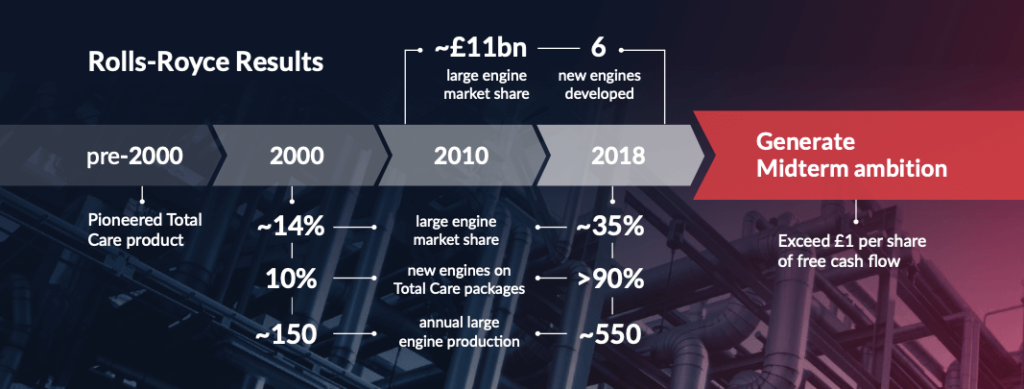
What kind of Field Service Organization are you?
We’ve talked at length about the industry-wide shift toward outcome-based service — but how exactly do you go from Point A to Point B? A helpful place to start is by determining what kind of service organization you currently are, and how that differs from an outcome-based service organization. Let’s take a closer look.
| Cost Center Model | Profit Center Model | Outcome-Driven Model |
|---|---|---|
| Answers to Director of Field Service Focused on reducing cost-to-serve Looks for ways to enhance operational efficiency Struggles with visibility, diagnostic capabilities, and coordinating availability | Answers to VP of Sales, Service, or Product Focused on competitive differentiation Looks for ways to eliminate equipment downtime wherever possible Struggles with anticipating equipment failure, technician preparation, lack of access to customer info and sales tools | Answers to COO Focused on delivering outcomes rather than products Looks for opportunities to differentiate from competitors and grow top-line revenue Struggles with commoditization, competition from companies with disruptive business models, and changing customer expectations |
Your company’s field service department may be operating according to a cost center model if it:
|
|
To get on track toward transitioning to an outcome-based service model, you need to ask the following:
- How often do our technicians require multiple visits to address service requests?
- How much does it cost us every time we dispatch a service technician to a customer site?
- How do we usually find out that a piece of equipment is malfunctioning?
- How often do we check in to see whether a piece of equipment is functioning properly?
- How frequently are our technicians unable to fix an issue because they don’t have the right parts, tools, or expertise?
Your company’s field service department may be operating according to a profit center model if it:
|
|
To get on track toward transitioning to an outcome-based service model, you need to ask the following:
- What actions are we taking to remain competitive as our products become more commoditized?
- How are we differentiating our business?
- Which of our products and/or services are most profitable, and which ones frustrate our customers the most?
- How often do our technicians require multiple visits to address maintenance issues?
- How do we ensure that we have the right people, parts, and tools for each service visit?
Last but certainly not least, your company‘s field service department may be operating according to an outcome-driven service model if it:
|
|
To take your service organization from outcome-driven to outcome-based, you need to start by asking the following:
- What is our strategy for differentiating our company from competitors as products become more commoditized?
- What role do services play in our long-term business strategy?
- What type of business will eventually disrupt us?
- What is our plan for developing new revenue streams?
- Are we taking steps to develop Product as a Service offerings?
- How are we responding to competitors that are developing Product as a Service offerings?
Servitization Metrics for Optimizing your Profitability and Performance
There are a few key performance indicators and metrics that your service organization can use to guide and even galvanize your transition to an outcome-based model.

Although metrics related to internal processes and functions are still important, you’ll also need to consider customer-facing metrics. Here are a few examples of what that might look like:
- Rather than adhere to time-bound maintenance schedules, you’ll start to manage schedules based on predictive maintenance alerts, which will enable you to base SLAs on resolution time.
- You’ll shift from a reactive to a proactive support model.
- Instead of a product-attached support and services model, in which revenue is dependent on administering services after a customer’s warranty period has ended, you’ll transition to an outcome and services model, in which revenue is generated from repeat service contracts, project-based services, and equipment outcomes.
- Field engineers become valued partners to customers, advising them on how to optimize consumption for usability and value, rather than just acting as technicians.
- Rather than rely solely on in-house expertise, you’ll have more opportunities to outsource and partner with other experts in your field.
- Your support organization enters into alignment with sales, marketing, and product development.
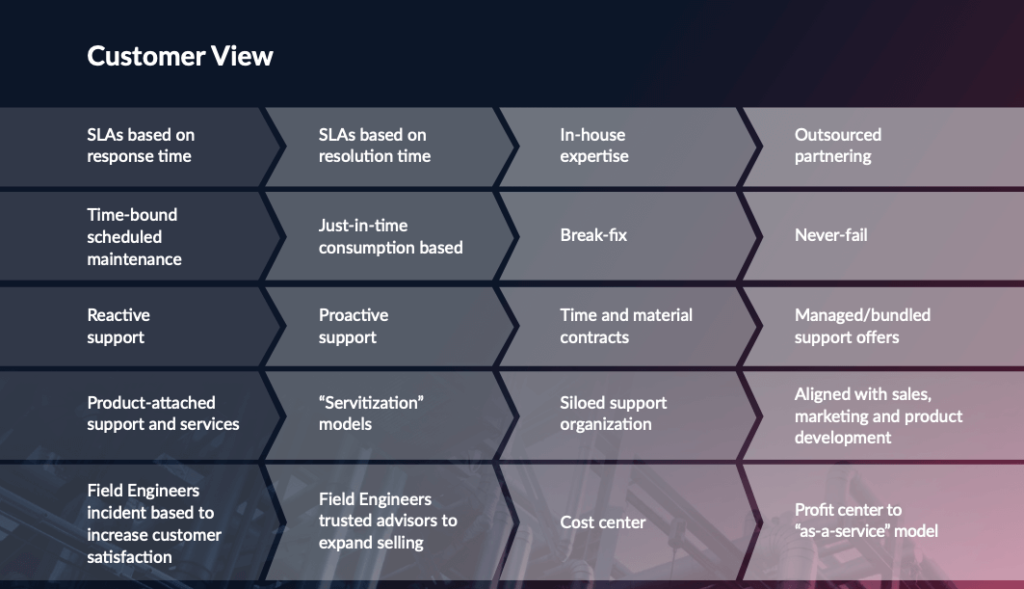
The Roadmap to Outcome-Based Service
The transition to an outcome-based service model is not an overnight transformation, but rather a gradual process that involves multiple steps.
Most service organizations choose to begin by focusing on their product view, making incremental improvements that extend the equipment lifecycle. Once you’ve made product enhancements, the next step is to do the same to service — this involves ensuring that you have the right parts, the right tools, and technicians with the right skills available whenever and wherever you need them.
As you optimize both the product and service sides of your organization, you’ll start to move into more of a static maintenance and service contract. From there, you’ll need to develop scheduled service, SLAs, and incident management to help run your service operation efficiently.
The next step is to look at dynamic monitoring and condition-based contracts, which require telemetry information and IoT connectivity in order to understand product performance — this will inform your go-to-market strategy. Once you know which of your products perform best, you can begin to have meaningful conversations about performance-based management and contracts.
By this point, you’re ready to make the move to Product as a Service and start selling uptime as opposed to physical equipment. We find this gradual approach to be helpful for service organizations because it enables them to stay laser-focused on understanding and optimizing their product.
The Three Key Phases of Outcome-Based Service
Here at Hitachi Solutions, we’ve defined a three-phased approach to adopting an outcome-based service model.
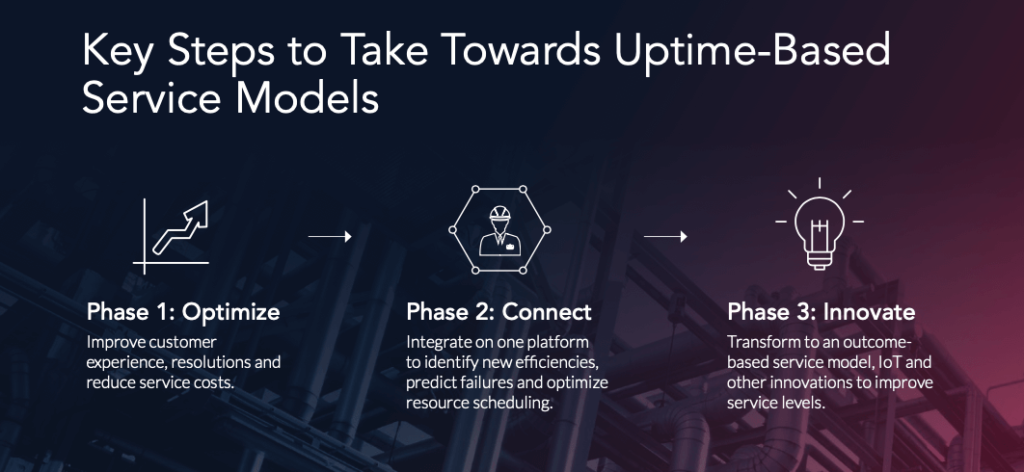
Phase One: Optimize
The first phase is all about understanding your data and assets. During this phase, it’s important to focus on:
- Reducing costs;
- Enhancing efficiency;
- Improving the customer experience;
- Establishing a single source of truth;
- Standardizing processes; and
- Introducing automation.
Although some organizations are tempted to skip right to phase two — Connect — optimizing existing operations helps build a solid foundation for future success.
Phase Two: Connect
Phase two prioritizes understanding how connected devices and processes complement your foundation. Thanks to AI, machine learning, cloud computing, and cognitive services, it’s easier than ever to achieve connectivity and build strong feedback loops. By leveraging these and other technologies, your organization will be able to create a unified platform with which to identify new efficiencies, predict failures, optimize resource scheduling, and gain an accurate view of how your assets actually work.
Phase Three: Innovate
By phase three, you’re officially ready to complete your transition to an outcome-based service model, having mastered prediction models, service models, and connectivity. You’re now ready to utilize Product as a Service, monetize and refine your approach, and enhance the strategic areas of your business.
Start Your Transformation with Hitachi Solutions
The journey to outcome-based service can sometimes be a challenging one; fortunately, you don’t have to go it alone.
Here at Hitachi Solutions, we’ve developed an entire practice around helping service organizations such as your transition to an outcome-based service model and, by extension, embrace Product as a Service. Our company is laser-focused on the Microsoft platform; in our 16+ years of field service experience, we’ve helped over 70 companies around the world implement industry-leading field service solutions, such as Dynamics 365 Field Service and our own IP, Hitachi Solutions Extended Field Service. We also have access to a vast network of subject matter experts who specialize in different industries and verticals, enabling us to deliver industry-specific insights on how to transform your field service organization and evolve for the future.
Take the first step toward adopting an outcome-based service model — contact Hitachi Solutions to get started.
